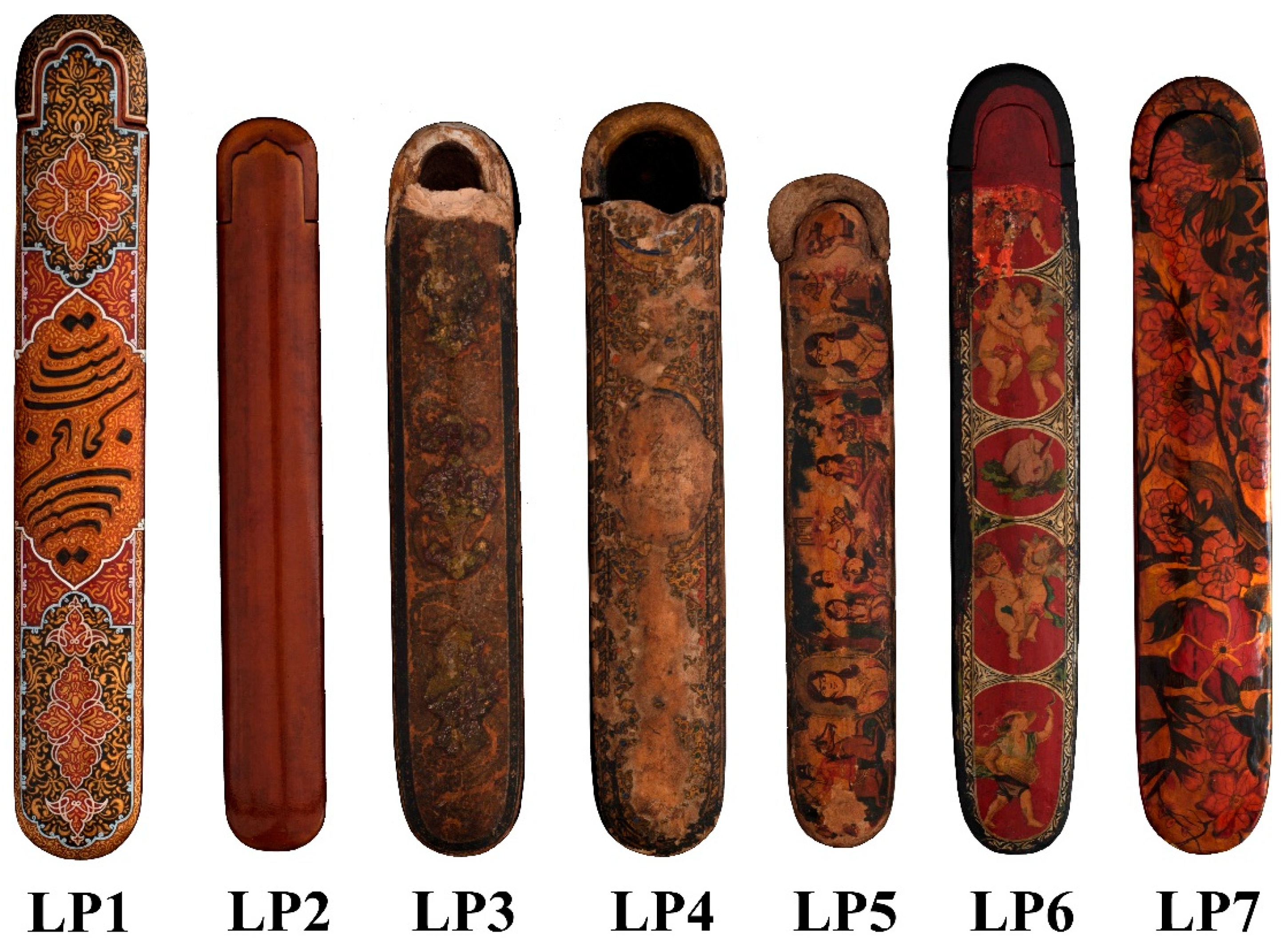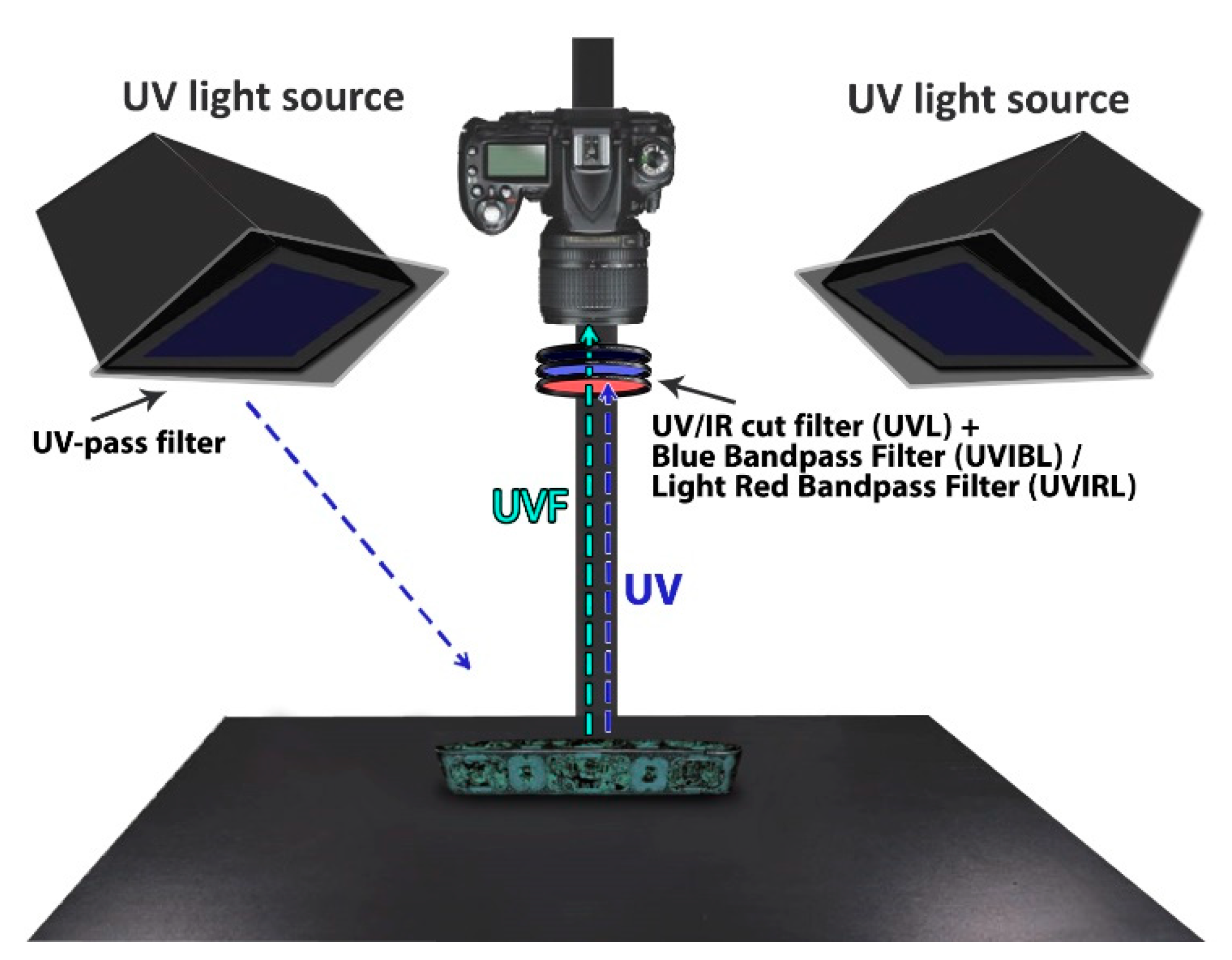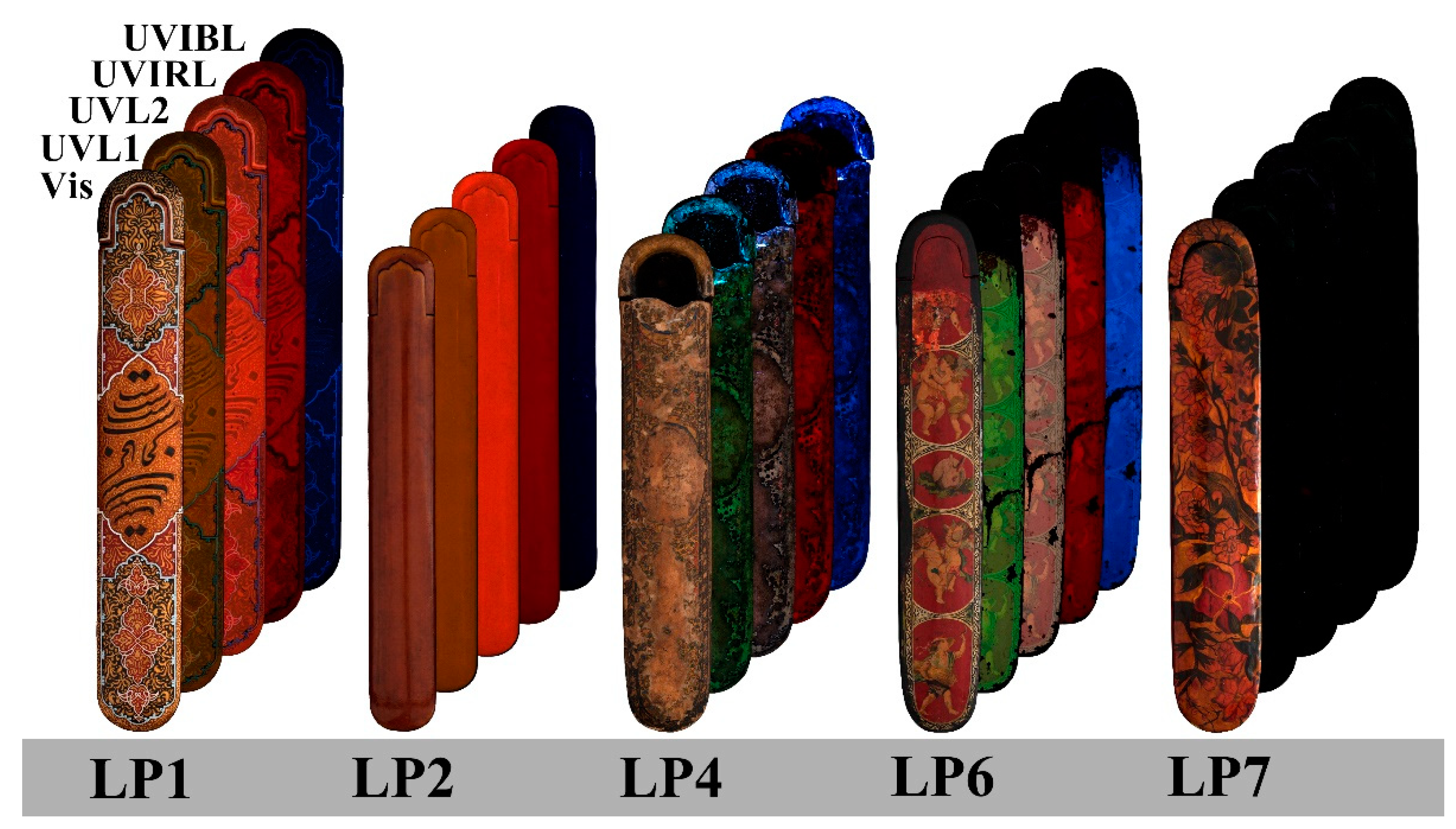Identification of Coatings on Persian Lacquer Papier Mache Penboxes by Fourier Transform Infrared Spectroscopy and Luminescence Imaging
Abstract
:1. Introduction
2. Materials and Methods
2.1. Samples
2.2. Fourier Transform Infrared Spectroscopy
2.3. Luminescence Imaging
3. Results and Discussion
3.1. FTIR Spectroscopy
3.2. Spectral Imaging
4. Conclusions
Author Contributions
Funding
Institutional Review Board Statement
Informed Consent Statement
Data Availability Statement
Acknowledgments
Conflicts of Interest
References
- Decq, L.; Jones, Y.; Steyaert, D.; Cattersel, V.; Indekeu, C.; Van Binnebeke, E.; Fremout, W.; Lynen, F.; Saverwyns, S. Black Lacquered Papier-mâché and Turned Wooden Furniture: Unravelling the Art History, Technology and Chemistry of the 19th-Century Japanning Industry. Stud. Conserv. 2019, 64 (Suppl. S1), S31–S44. [Google Scholar] [CrossRef] [Green Version]
- Robinson, B.W. Some thoughts on Qajar Lacquer. In Lacquerwork in Asia and Beyond; Watson, W., Ed.; University of London, Percival David Foundation of Chinese Art, School of Oriental and African Studies: London, UK, 1982; pp. 67–77. [Google Scholar]
- Robinson, B.W. Persian Lacquer in the Bern Historical Museum. Iran 1970, 8, 47. [Google Scholar] [CrossRef]
- von der Osten-Woldenburg, H. Radartomographie der römischen Villa in Epfendorf TT—Radar tomography of the Roman villa in Epfendorf. Fundber. Baden-Württemberg 1999, 23, 243–252. [Google Scholar]
- Diba, L.S. Lacquerwork of Safavid Persia and Its Relationship to Persian Painting; The Institute of Fine Arts, New York University: New York, NY, USA, 1994. [Google Scholar]
- Fehervari, G. Near Eastern Lacquerwork: History and Early Guidance. In Lacquerwork in Asia and Beyond; Watson, W., Ed.; University of London, Percival David Foundation of Chinese Art, School of Oriental and African Studies: London, UK, 1982; pp. 225–231. [Google Scholar]
- Kiani, M.Y. Early Lacquer in Iran. In Lacquerwork in Asia and Beyond; Watson, W., Ed.; University of London, Percival David Foundation of Chinese Art, School of Oriental and African Studies: London, UK, 1982; pp. 211–224. [Google Scholar]
- Robinson, B. Qajar Lacquer. Muqarnas 1989, 6, 131–146. [Google Scholar] [CrossRef]
- Porter, Y.; Butani, S. Painters, Paintings and Books: An Essay on Indo-Persian Technical Literature, 12–19th Centuries; Routledge: Abingdon, UK, 2020. [Google Scholar]
- Khalili, N.D. Persian Lacquer Painting in the 18th and 19th Centuries; SOAS University of London: London, UK, 1988. [Google Scholar]
- Echard, J.; Benoit, C.; Peris-Vicente, J.; Malecki, V.; Gimeno-Adelantado, J.; Vaiedelich, S. Gas chromatography/mass spectrometry characterization of historical varnishes of ancient Italian lutes and violin. Anal. Chim. Acta 2007, 584, 172–180. [Google Scholar] [CrossRef] [PubMed]
- Modugno, F.; Ribechini, E. GC/MS in the Characterisation of Resinous Materials. In Organic Mass Spectrometry in Art and Archaeology; John Wiley & Sons: Hoboken, NJ, USA, 2009; pp. 215–235. [Google Scholar]
- Scalarone, D.; Chiantore, O. Py-GC/MS of natural and synthetic resins. In Organic Mass Spectrometry in Art and Archaeology; Colombini, M.P., Modugno, F., Eds.; John Wiley & Sons: Hoboken, NJ, USA, 2009; pp. 327–361. [Google Scholar]
- Ribechini, E. Direct mass spectrometric techniques: Versatile tools to characterise resinous materials. In Organic Mass Spectrometry in Art and Archaeology; Colombini, M.P., Modugno, F., Eds.; John Wiley & Sons: Hoboken, NJ, USA, 2009; pp. 77–95. [Google Scholar]
- Chiavari, G.; Fabbri, D.; Prati, S. Characterisation of natural resins by pyrolysis—Silylation. Chromatographia 2002, 55, 611–616. [Google Scholar] [CrossRef]
- Dietemann, P.; Herm, C. GALDI-MS applied to characterise natural varnishes and binders. In Organic Mass Spectrometry in Art and Archaeology; Colombini, M.P., Modugno, F., Eds.; John Wiley & Sons: Hoboken, NJ, USA, 2009; pp. 131–163. [Google Scholar]
- Daher, C.; Bellot-Gurlet, L. Non-destructive characterization of archaeological resins: Seeking alteration criteria through vibrational signatures. Anal. Methods 2013, 5, 6583. [Google Scholar] [CrossRef] [Green Version]
- Daher, C.; Bellot-Gurlet, L.; Le Hô, A.-S.; Paris, C.; Regert, M. Advanced discriminating criteria for natural organic substances of Cultural Heritage interest: Spectral decomposition and multivariate analyses of FT-Raman and FT-IR signatures. Talanta 2013, 115, 540–547. [Google Scholar] [CrossRef] [Green Version]
- Daher, C.; Paris, C.; Le Hô, A.-S.; Bellot-Gurlet, L.; Échard, J.-P. A joint use of Raman and infrared spectroscopies for the identification of natural organic media used in ancient varnishes. J. Raman Spectrosc. 2010, 41, 1494–1499. [Google Scholar] [CrossRef] [Green Version]
- Daher, C.; Pimenta, V.; Bellot-Gurlet, L. Towards a non-invasive quantitative analysis of the organic components in museum objects varnishes by vibrational spectroscopies: Methodological approach. Talanta 2014, 129, 336–345. [Google Scholar] [CrossRef] [PubMed] [Green Version]
- Ciofini, D.; Striova, J.; Camaiti, M.; Siano, S. Photo-oxidative kinetics of solvent and oil-based terpenoid varnishes. Polym. Degrad. Stab. 2016, 123, 47–61. [Google Scholar] [CrossRef] [Green Version]
- Winkler, W.; Kirchner, E.C.; Asenbaum, A.; Musso, M. A Raman spectroscopic approach to the maturation process of fossil resins. J. Raman Spectrosc. 2001, 32, 59–63. [Google Scholar] [CrossRef]
- Beltran, V.; Salvador, B.; Butí, S.; Pradell, T. Ageing of resin from Pinus species assessed by infrared spectroscopy. Anal. Bioanal. Chem. 2016, 408, 4073–4082. [Google Scholar] [CrossRef] [Green Version]
- Azémard, C.; Vieillescazes, C.; Ménager, M. Effect of photodegradation on the identification of natural varnishes by FT-IR spectroscopy. Microchem. J. 2014, 112, 137–149. [Google Scholar] [CrossRef]
- Salzer, R. Infrared and Raman Spectroscopy. In Conservation Science for the Cultural Heritage: Applications of Instrumental Analysis; Varella, E.A., Ed.; Springer Science & Business Media: Berlin/Heidelberg, Germany, 2012; Volume 79, pp. 65–79. [Google Scholar]
- de la Rie, E.R. Fluorescence of paint and varnish layers (Part I). Stud. Conserv. 1982, 27, 1–7. [Google Scholar]
- de la Rie, E.R. Fluorescence of paint and varnish layers (Part II). Stud. Conserv. 1982, 27, 65–69. [Google Scholar]
- de la Rie, E.R. Fluorescence of paint and varnish layers (part III). Stud. Conserv. 1982, 27, 102–108. [Google Scholar]
- Goulinat, J.-G. L’apport des procédés scientifiques dans la restoration des peintures TT—The contribution of scientific procedures to the restoration of paintings. Mous. Bull. l’Office Int. Musées 1931, 15, 47–53. [Google Scholar]
- Rorimer, J.J. Ultra-Violet Rays and Their Use in the Examination of Works of Art; Metropolitan Museum of Art: New York, NY, USA, 1931. [Google Scholar]
- Hickey-Friedman, L. A Review of Ultra-Violet Light and Examination Techniques. In Objects Specialty Group Postprints; The American Institute for Conservation of Historic & Artistic Works: Washington, DC, USA, 2002; Volume 9, pp. 161–168. [Google Scholar]
- Dyer, J.; Verri, G.; Cupitt, J. Multispectral Imaging in Reflectance and Photo-Induced Luminescence Modes: A User Manual. European CHARISMA Project, 2013. Available online: https://www.researchgate.net/profile/Giovanni-Verri-2/publication/267266175_Multispectral_Imaging_in_Reflectance_and_Photo-induced_Luminescence_modes_A_User_Manual/links/5448e7560cf2d62c3052d2b7/Multispectral-Imaging-in-Reflectance-and-Photo-induced-Luminescence-modes-A-User-Manual.pdf (accessed on 8 July 2021).
- McGlinchey Sexton, J.; Messier, P.; Chen, J.J. Development and testing of a fluorescence standard for documenting ultraviolet induced visible fluorescence. In Proceedings of the 42nd Annual Meeting of the American Institute for Conservation, San Francisco, CA, USA, 28–31 May 2014. [Google Scholar]
- CAMEO. CAMEO Materials Database. Conservation & Art Materials Encyclopedia Online. 2018. Available online: http://cameo.mfa.org/wiki/Category:Materials_database (accessed on 8 July 2021).
- Measday, D. A Summary of Ultra-Violet Fluorescent Materials Relevant to Conservation. AICCM Natl. Newsl. 2017, 137. Available online: https://b2n.ir/p15183 (accessed on 8 July 2021).
- Verri, G.; Saunders, D. Xenon flash for reflectance and luminescence (multispectral) imaging in cultural heritage applications. Br. Mus. Tech. Res. Bull. 2014, 8, 83–92. [Google Scholar]
- Kushel, D. Photographic Techniques. In The AIC Guide to Digital Photography and Conservation Documentation; Frey, F.S., Ed.; American Institute for Conservation of Historic and Artistic Works: Washington, DC, USA, 2017. [Google Scholar]
- Cosentino, A. Practical notes on ultraviolet technical photography for art examination. Conserv. Patrim. 2015, 21, 53–62. [Google Scholar] [CrossRef] [Green Version]
- Khalili, N.D.; Robinson, B.W.; Stanley, T. Lacquer of the Islamic Lands; Nour Foundation: New York, NY, USA, 1996. [Google Scholar]
- Babaylou, A.N.; Boyaghchi, M.A.; Najafi, F.; Achachlouei, M.M.; Tabriz Islamic Art University; Art University of Isfahan, Institute for Color Science and Technology. Review on Identification of Diterpenoid Resins in Artworks Varnishes by FTIR. J. Res. Archaeom. 2016, 2, 67–80. [Google Scholar] [CrossRef] [Green Version]
- Ploeger, R.; Scalarone, D.; Chiantore, O. The characterization of commercial artists’ alkyd paints. J. Cult. Herit. 2008, 9, 412–419. [Google Scholar] [CrossRef]
- Hayes, P.A.; Vahur, S.; Leito, I. ATR-FTIR spectroscopy and quantitative multivariate analysis of paints and coating materials. Spectrochim. Acta Part A Mol. Biomol. Spectrosc. 2014, 133, 207–213. [Google Scholar] [CrossRef]
- Anghelone, M.; Jembrih-Simbürger, D.; Schreiner, M. Influence of phthalocyanine pigments on the photo-degradation of alkyd artists’ paints under different conditions of artificial solar radiation. Polym. Degrad. Stab. 2016, 134, 157–168. [Google Scholar] [CrossRef]
- Derrick, M.R.; Stulik, D.; Landry, J.M. Infrared Spectroscopy in Conservation Science; Getty Conservation Institute: Los Angeles, CA, USA, 2000. [Google Scholar]
- Invernizzi, C.; Rovetta, T.; Licchelli, M.; Malagodi, M. Mid and Near-Infrared Reflection Spectral Database of Natural Organic Materials in the Cultural Heritage Field. Int. J. Anal. Chem. 2018, 2018, 1–16. [Google Scholar] [CrossRef]
- Invernizzi, C.; Daveri, A.; Vagnini, M.; Malagodi, M. Non-invasive identification of organic materials in historical stringed musical instruments by reflection infrared spectroscopy: A methodological approach. Anal. Bioanal. Chem. 2017, 409, 3281–3288. [Google Scholar] [CrossRef] [PubMed]
- Brajnicov, S.; Bercea, A.; Marascu, V.; Matei, A.; Mitu, B. Shellac Thin Films Obtained by Matrix-Assisted Pulsed Laser Evaporation (MAPLE). Coatings 2018, 8, 275. [Google Scholar] [CrossRef] [Green Version]
- Kirsh, A.; Levenson, R.S. Seeing Through Paintings: Physical Examination in Art Historical Studies; Yale University Press: New Haven, CT, USA, 2000. [Google Scholar]
- Giachet, M.T.; Schröter, J.; Brambilla, L. Characterization and Identification of Varnishes on Copper Alloys by Means of UV Imaging and FTIR. Coatings 2021, 11, 298. [Google Scholar] [CrossRef]
- Sutherland, K. Bleached shellac picture varnishes: Characterization and case studies. J. Inst. Conserv. 2010, 33, 129–145. [Google Scholar] [CrossRef]




| Imaging Technique | Filter(s) in Front of Radiation Sources | Filter(s) in Front of Camera | Range Investigated |
|---|---|---|---|
| Visible-reflected Imaging (VIS) | 2 × Youngenu NY660 Xenon flashlight (without filter) | Baader UV/IR Cut | 420–680 nm |
| UV-induced visible luminescence imaging (UVL) | +2 × Hoya U-360 | Baader UV/IR Cut | 420–680 nm |
| UV-induced Blue luminescence imaging (UVIBL) | +2 × Hoya U-360 | Baader UV/IR Cut + MidOpt BP470 | 425–495 nm |
| UV-induced Red luminescence imaging (UVIRL) | +2 × Hoya U-360 | Baader UV/IR Cut + MidOpt BP635 | 615–645 nm |
| Samples | Coating Type * | Imaging Methods | |||
|---|---|---|---|---|---|
| UVL1 | UVL2 | UVIRL | UVIBL | ||
| LP1 | Shellac | Brown | Orange | Red | Dark blue |
| LP2 | |||||
| LP3 | Kaman oil | Green | Milky | Red | Light blue |
| LP4 | |||||
| LP5 | |||||
| LP6 | |||||
| LP7 | Alkyd resin | Black | Black | Black | Black |
Publisher’s Note: MDPI stays neutral with regard to jurisdictional claims in published maps and institutional affiliations. |
© 2021 by the authors. Licensee MDPI, Basel, Switzerland. This article is an open access article distributed under the terms and conditions of the Creative Commons Attribution (CC BY) license (https://creativecommons.org/licenses/by/4.0/).
Share and Cite
Koochakzaei, A.; Nemati Babaylou, A.; Jelodarian Bidgoli, B. Identification of Coatings on Persian Lacquer Papier Mache Penboxes by Fourier Transform Infrared Spectroscopy and Luminescence Imaging. Heritage 2021, 4, 1962-1969. https://0-doi-org.brum.beds.ac.uk/10.3390/heritage4030111
Koochakzaei A, Nemati Babaylou A, Jelodarian Bidgoli B. Identification of Coatings on Persian Lacquer Papier Mache Penboxes by Fourier Transform Infrared Spectroscopy and Luminescence Imaging. Heritage. 2021; 4(3):1962-1969. https://0-doi-org.brum.beds.ac.uk/10.3390/heritage4030111
Chicago/Turabian StyleKoochakzaei, Alireza, Ali Nemati Babaylou, and Behrooz Jelodarian Bidgoli. 2021. "Identification of Coatings on Persian Lacquer Papier Mache Penboxes by Fourier Transform Infrared Spectroscopy and Luminescence Imaging" Heritage 4, no. 3: 1962-1969. https://0-doi-org.brum.beds.ac.uk/10.3390/heritage4030111






